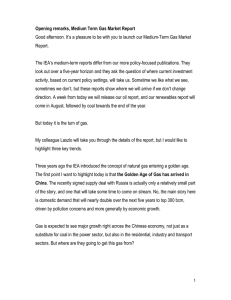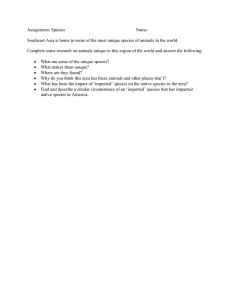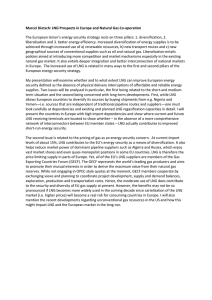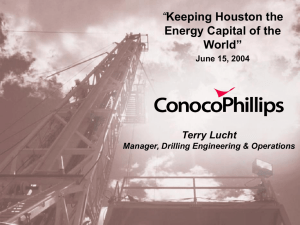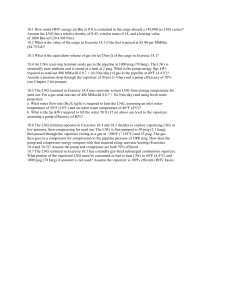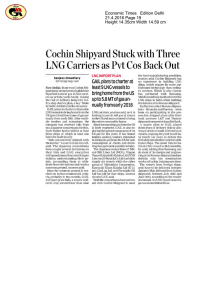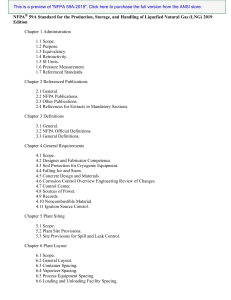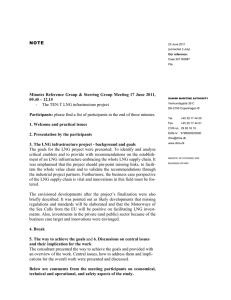Michael J Economides
advertisement
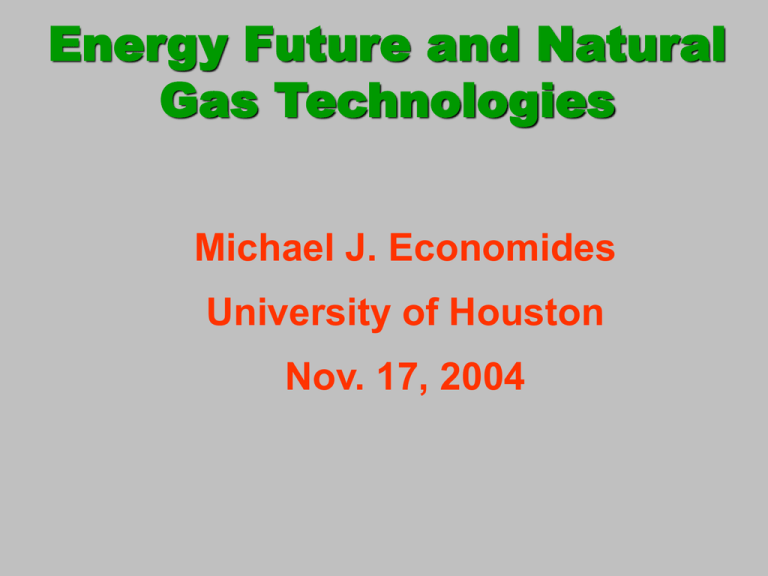
Energy Future and Natural Gas Technologies Michael J. Economides University of Houston Nov. 17, 2004 The Continuous Energy Crisis of the 21st Century Oil over $50 (It is not just OPEC) Venezuela, Nigeria, Iraq China has gone berserk Price may go even higher, soon Natural gas at $10-plus Alan Greenspan (Over and over again) (“LNG the only solution”) US ENERGY CONSUMPTION U.S. Energy Consumption by Source 160 Other 140 Hydropower Nuclear 120 4.3% 2.3% 6.2% Coal 100 Oil 3% 3% 23.3% 8% 80 23% 24% 60 24% 40 39% 40 20 0 19 70 19 72 19 74 19 76 19 78 19 80 19 82 19 84 19 86 19 88 19 90 19 92 19 94 19 96 19 98 20 00 20 02 20 04 20 06 20 08 20 10 20 12 20 14 20 16 20 18 20 20 20 22 20 24 Energy, Quatrillion Btu Natural Gas Year The New Energy Economy Carbon content: • • • • • Wood (1800s) Coal Oil Natural Gas Hydrogen (envisioned) High Increasingly: • Clean Medium • Energy intensive Low • Technologically sophisticated (Zero) • Distributed The emerging “hydrogen economy” better characterized as a “fuel cell economy” that will run on natural gas--i.e. a “natural gas economy” US Energy Flow (Quadrillion BTU) 2003 EIA Annual Energy Review Energy Use in the United States (2003) Total 97 Quads (Direct)* Residential 20% (34%) Commercial 18% (24%) Industrial 34% (66%) Transportation 28% (99.8%)** *Rest is electricity **All oil Candidate John Kerry on Meet the Press, Sunday, April 18 “I'm going to move the United States of America towards energy independence. I'm going to set a goal, that by the year 2020, 20 percent of our electricity will be produced from alternative and renewable sources.” Capacity Brought on Line for Electric Power Generation by Fuel Type (1950-2002) 80,000 Name Plate Capacity MW Recent years have seen an explosion in new gas fired generation, but little building in other fuels. Other Petroleum Hydro Nuclear Gas Coal 70,000 60,000 50,000 40,000 30,000 20,000 10,000 Source: RDI PowerDat database. Last updated 9/15/03. 2001 1998 1995 1992 1989 1986 1983 1980 1977 1974 1971 1968 1965 1962 1959 1956 1953 1950 0 World Gas Prices Russia $0.80 Europe $3.70 U.S. $5.50 Venezuela $0.75 Argentina $1.25 Source: American Chemistry Council Middle East $0.60 Indonesia $1.20 U.S. Natural Gas Demand and Supply Sources 60 Tcf per year 50 Economides and Oligney “twist” demand forecast Japan-sized LNG Natural gas hydrates? DOE/EIA demand forecast 40 Arctic Deepwater 30 Canada 20 Shallow Offshore Unconventional 10 Conventional 0 2000 2004 2008 2010 2012 2020 LNG tanker underway Photo Courtesy of BP Announced June 12, 2001 Announced October 29, 2003 Cheniere LNG Shell LNG Exxon Mobil announced plans to build the nation's largest LNG import terminal for 2 BCF/d from Qatar to land-based locations at either Corpus Christi, Sabine Pass or Mobile, Ala. October 15, 2003 CNG Transport CNG Cargo Containment System Scenario Replacing Oil Imported for Transportation with Gas U.S. Energy Consumption by Source 160 Other 140 Hydropower Nuclear 120 4.3% 2.3% 6.2% Coal 100 Oil 3% 3% 23.3% 8% 80 23% 24% 60 24% 40 39% 40 20 Industrial Use 0 19 70 19 72 19 74 19 76 19 78 19 80 19 82 19 84 19 86 19 88 19 90 19 92 19 94 19 96 19 98 20 00 20 02 20 04 20 06 20 08 20 10 20 12 20 14 20 16 20 18 20 20 20 22 20 24 Energy, Quatrillion Btu Natural Gas Year Extravagant Target To replace all imported oil with gas by the year 2024 (15 MMBOPD), there must be 90 BCF/D of additional gas imported (beyond what is expected for power generation) Modest Target To replace 1/3 of imported oil with gas by the year 2024 (5 MMBOPD), there must be 30 BCF/D of additional gas imported (beyond what is expected for power generation) Gas-To-Liquids (GTL) • What are they? • A technology which promises to complement LNG in transporting remote natural gas to distant markets in the absence of existing pipelines. • Unlike LNG, which is liquefied gas that is vaporized for use, GTL processes convert the gas into hydrocarbon liquids. • Require sustained $24 oil price Dual-Mode Vehicle Alternative environmentally friendly, point to point travel at high speed private mass transit ```````` Golfing for Hydrogen Bovine Brain Power > Mad Car Disease?
